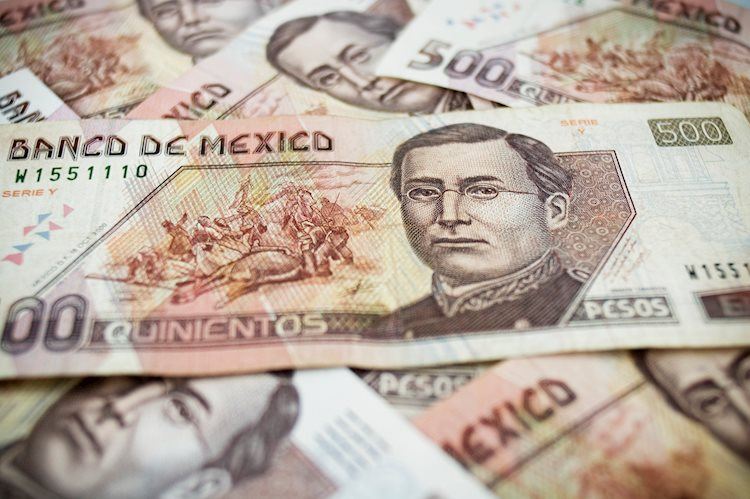Jobs
Mexican Peso weakens as inflation rises and strong US jobs data lifts USD

- Mexican Peso slides as Mexico’s headline inflation rises slightly in early October.
- IMF projects Mexico’s GDP growth at 1.5% in 2024, compared to a stronger 2.8% forecast for the US economy.
- Strong US jobs data and improving PMI figures support the US Dollar.
Mexican Peso losses a step against the Greenback during the North American session on Thursday amid an improvement in risk appetite. Mexico’s inflation edged slightly up in the first 15 days of October, while US jobs data was solid, underpinning the US Dollar. At the time of writing, the USD/MXN trades at 19.85, up over 0.10%.
The Instituto Nacional de Estadística Geografía e Informatica (INEGI) revealed that Mexico’s headline inflation accelerated in the first half of October. However, the underlying rate moderated to levels last seen in February 2021. This reinforced expectations that the Bank of Mexico (Banxico) would lower borrowing costs after economic activity and Retail Sales data in August suggested the economy was losing ground.
Projections by the International Monetary Fund (IMF) suggest Mexico’s economy is expected to grow by 1.5% in 2024 and 1.3% in 2025. On the contrary, the IMF revealed the US economy will hit 2.8% Gross Domestic Product (GDP) growth in 2024 and 2.2% in 2025.
In addition, a strong jobs market report by the US Department of Labor revealed that the number of Americans filing for unemployment claims in the week ending October 19 was lower than expected.
Recently, S&P Global revealed that Manufacturing and Services PMI in October improved, though the former remained in contractionary territory. This lifted the Composite PMI from 54.0 to 54.3, a tailwind for the Greenback.
Earlier, the Cleveland Fed’s Beth Hammack said that core inflation has eased but isn’t yet at 2% target, adding that prices had cooled amid strong job market and “good growth.” She stated it is reasonable to expect more disinflation.
Daily digest market movers: Mexican Peso wavers amid mixed inflation readings
- Mexico’s mid-month inflation report in October was 4.69% YoY, up from the 4.65% expected and the previous reading of 4.66%. Underlying inflation data rose by 3.87% YoY, down from 3.95%, though it missed the mark of 3.82%.
- On a monthly basis, mid-month inflation rose by 0.43% MoM, exceeding the previous reading of 0.09% and estimates of 0.40%.
- Analysts at Monex suggested that the latest inflation data could prevent Banxico from lowering rates in subsequent meetings. Banxico’s next meeting is on November 14.
- Initial Jobless Claims for the week ending October 19 rose by 227K, below estimates of 242K and the previous reading of 241K.
- October S&P Global Manufacturing PMI came at 47.8, up from 47.3 in September and exceeding forecasts of 47.5. The Services PMI improved from 55.2 to 55.3, above the 55.0 projected by analysts.
- Data from the Chicago Board of Trade, via the December fed funds rate futures contract, shows investors estimate 48 bps of Fed easing by the end of the year.
USD/MXN technical outlook: Mexican Peso consolidates below 20.00
The USD/MXN uptrend remains intact, though it has consolidated within the 19.80-20.00 range. Momentum shows that sellers have stepped in with the Relative Strength Index (RSI) aiming lower, capping the exotic’s pair advance.
If buyers clear the 20.00 figure, they could test the weekly peak at 20.09. On further strength, the USD/MXN could aim toward the year-to-date (YTD) high at 20.22, ahead of key psychological levels of 20.50 and 21.00.
On the other hand, if sellers reclaim the October 18 low at 19.64, this could pave the way for a challenge to 19.50. The next move would be toward the October 4 swing low of 19.10 before testing 19.00.
Banxico FAQs
The Bank of Mexico, also known as Banxico, is the country’s central bank. Its mission is to preserve the value of Mexico’s currency, the Mexican Peso (MXN), and to set the monetary policy. To this end, its main objective is to maintain low and stable inflation within target levels – at or close to its target of 3%, the midpoint in a tolerance band of between 2% and 4%.
The main tool of the Banxico to guide monetary policy is by setting interest rates. When inflation is above target, the bank will attempt to tame it by raising rates, making it more expensive for households and businesses to borrow money and thus cooling the economy. Higher interest rates are generally positive for the Mexican Peso (MXN) as they lead to higher yields, making the country a more attractive place for investors. On the contrary, lower interest rates tend to weaken MXN. The rate differential with the USD, or how the Banxico is expected to set interest rates compared with the US Federal Reserve (Fed), is a key factor.
Banxico meets eight times a year, and its monetary policy is greatly influenced by decisions of the US Federal Reserve (Fed). Therefore, the central bank’s decision-making committee usually gathers a week after the Fed. In doing so, Banxico reacts and sometimes anticipates monetary policy measures set by the Federal Reserve. For example, after the Covid-19 pandemic, before the Fed raised rates, Banxico did it first in an attempt to diminish the chances of a substantial depreciation of the Mexican Peso (MXN) and to prevent capital outflows that could destabilize the country.









